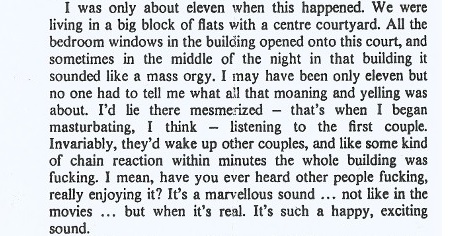His ‘n’ Hers (The Sisters EP, 1994)
His ‘n’ Hers (Live film, ‘Butt Naked’ 1994)
His ‘n’ Hers (Live film, ‘The Beat’ 1994)
His ‘n’ Hers (Live film,’ 1994)
His ‘n’ Hers (Live film, Pomona, California, 2011)
Compilation of live adlibs
His ‘n’ Hers at Pulpwiki
“This was the English passion, not for self-improvement or culture or wit, but for DIY, Do It Yourself, for bigger and better houses with more mod cons, the painstaking accumulation of comfort and, with it, status – the concrete display of earned cash.”
Hanif Kureishi, The Buddha of Suburbia
“In the homes of the middle-middles and below, the ‘lounge’ (as they call it) is likely to have a fitted carpet. The higher castes prefer bare floorboards, often part-covered with old Persian carpets or rugs. The middle-middle ‘lounge’ might have a cocktail cabinet, and their dining room a hostess trolley. The contents of lower-middle and some upper-working ‘front rooms’ will often be obscured by net curtains, but they are likely to be dominated by large television sets and, among the older generation, may boast embroidered or lacy covers on the arms of chairs and carefully displayed ‘collections’ of small objects (spoons, glass animals, Spanish dolls, figurines) from package holidays or mail-order catalogues”
Kate Fox, Watching the English – The Hidden Rules of English Behaviour
“Do you have any idea what it’s like being English? Being so correct all the time, being so stifled by this dread of doing the wrong thing, of saying to someone “Are you married?” and hearing “My wife left me this morning,” or saying, uh, “Do you have children?” and being told they all burned to death on Wednesday. You see, Wanda, we’ll all terrified of embarrassment. That’s why we’re so… dead. Most of my friends are dead, you know, we have these piles of corpses to dinner.”
John Cleese in ‘A Fish Called Wanda’
“Are you genuinely frightened by James Dean posters, Jarvis?”
“They’re everywhere. In clip frames. That ‘Boulevard Of Broken Dreams’ thing. He’s there with his coat, hunched up, in Times Square. You grow up seeing sad kids trying to look like him. Every time you go to get a takeaway he’s there on the wall. It’s like Marilyn Monroe: they’re just around so much you get sick of the cliché. They represent a lack of imagination. Pathetic lip service to ‘I’m a rebel’. They’ve had all the life sucked out of them through over-use. The notion of “rebellion” seems increasingly dodgy… In music it’s stone-dead now. Institutionalised. Karaoke. Guns N’Roses.”
Interview in Melody Maker, 1994
Camille: Jarvis did this thing that I love. At first I thought it was weird, but now I like it. When we go out he checks to see what I’m wearing, like the colours or shapes. It’s not that he tries to match me but he can dress in the same family of colours. It’s this old school way of showing that you belong.
Jarvis: Yeah, but it’s not like we wear exactly the same thing. It’s not like it’s his n’ hers.
Camille: No, no, that’s not what I’m saying at all. It’s just like the same family of colours.
Jarvis: It’s about wearing something related.
Interview with Jarvis Cocker and Camille Bidault-Waddington at ONTD
Viewed from afar, English culture – particularly middle class English culture – is, to put it mildly, fucking weird. We are obsessed with rules – how to dress, how to eat, how to decorate your house, how to speak, how to interact with other people – and will use these indicators to instantly label strangers as belonging to a certain place and a certain class – or worse for not belonging to it, for importing ideas from outside, and therefore being either pretentious or morally suspect. It’s a deeply conservative, parochial instinct, but one which sometimes manifests itself, ironically, in the production of eccentrics. If you’re going to rebel against this suffocating duvet of a culture then you need to reject it entirely, take everything on your own terms – hence William Blake, Oscar Wilde, George Sitwell, Aleister Crowley, W. Heath Robinson, Stanley Unwin, Vivian Stanshall, Quentin Crisp, Alan Moore, Jarvis Cocker*…
That’s not a particularly happy list of people. British cultural norms are a heavy weight to cast off, and they leave their mark in a million petty, annoying ways. We are a small island, constantly in the grip of obsessions and fads. Entertainment, arts, food, people – these all seem to become famous at the whims of a selection of tastemakers, without the intervention of the public at all. Things arrived at in a more democratic manner – let’s call it pop culture / music** – are looked down on as being lower class, vulgar, simple, rubbish – and if you admit to liking them then you are, once again, either pretentious or somehow wrong in the head. Stepping out of what is accepted for your social group would cause embarrassment, and that would never do.
Embarrassment is a central tenet of the English mind, and a taste for moderation follows as an ingrained reflex. To be showy is to make a scene, and to purchase the same tasteful soft-furnishings as your friends and neighbours is a sure-fire method of avoiding burdening others with having to react to your tastes or emotions. Unconsciously we create boundaries between classes, regions and “foreign” – and this acts as a shortcut to know who’s in your circles and who isn’t. Pulp, meanwhile, are attempting to create their own circle, one constructed in opposition to these boundaries and prejudices. Beyond this song we have the very concept of “Pulp people” – the lists of Pulp things on concert flyers – the messages on the back of sleeves – all very inclusive, but all about rejecting the mediocrity of compromised everyday life.
But why reject compromise and comfort? Just “to be different”? Perhaps the enemy here is familiarity itself – for many this is the only source of comfort in an unpredictable world, but for others it has the effect of numbing the mind to all sensations. We (the narrator) are in the latter group, of course, let’s call it Modern Life is Suffocating. The woman in His ‘n’ Hers is a refuge from this feeling, but she also seems to be a member of the first group rather than the second. We are reminded from time to time that she’s an actual person, but she’s nevertheless viewed through the prism of his obsession. All he can see are the clichés, the litany of household tat, and even sex (the escape hatch in My Legendary Girlfriend and Sheffield: Sex City) has been reduced to a mechanical series of IKEA instructions – “pull the units down’, “shove it in sideways”. There’s a tangible disgust in his self-awareness of this, a horror in his own feelings, a shame, as desire to hide. This might seem strange (because he doesn’t seem to be doing anything terribly wrong) until you consider the obvious conclusion; that we’re talking about a dangerous, out-of-control fetish. While the narrator is repelled and alienated by these signifiers, he’s also secretly attracted to them. Each time, at the end of the chorus, he submits to her, but not enough to allow himself to be subsumed by these norms. Couplehood itself is a trap for him, he will lose himself in the creation of ‘us’ – a final surrender to everything he opposes, but he simply can’t help it. It’s a whirlpool of intense conflicting feelings, and he’s drowning.
This is the real difference from Frightened; the conjuring of all of this has been done on an extreme, but emotionally convincing level. It isn’t that Jarvis genuinely really feels this way (at least we hope), more that he’s been able to extrapolate his feelings to their unnatural conclusion. And with this sense of direction, his voice suddenly works too. We start with him sounding harsh and metallic, cold with an edge of desperation, and then witness him continually straining, losing his façade and breaking. This tension continues until the spoken word section*** salvaged from Frightened appears. Now it’s a confession to his girlfriend, who has asked him, harmlessly enough, what he’s frightened of. The resultant list of middle-class tat concludes with him admitting to a terror of “evenings in the Brincliffe Oaks, searching for a conversation” – i.e. numbness, absence of thought. “Are you stupid?” she says, and he surrenders once again. For a moment it seems that she can make it all better, drown the fear in earthy sexual joy and laughter, but then we cut back to “Are we going to do it again…?” and there is no redemption.
Of course, all this would’ve counted for nothing if His ‘n’ Hers wasn’t such an accomplished piece of music. Built more like a piece of ambient dance music than a traditional rock or pop song, it consists of various elements being added and then dropped as it progresses, with the illusion of normality being maintained only by Steve’s chugging backgrounded bassline and the mandatory gear-shift in and out of the chorus.
The first element to be introduced, and probably the most memorable, is Candida’s brilliantly ridiculous popcorn-style keyboard sequence, but the moment the song comes alive for me is with the looped drumroll dropped into the song at 40 seconds in. Then there’s the sickly waves of synth drone built up by Candida and Ed Buller. After the first chorus the drum loop changes to a Magnus-style tribal battering, then the creepy wandering guitar line starts to emerge, growing in prominence until the whole song has shifted its mood to an Italian horror soundtrack. Finally, as we get to “I want to…” everything comes back in together; a wave of intensity, which then breaks and falls back to the maddening background pressure.
It’s an astounding piece of music – all the more so for *not* jumping out at you. This sort of thematic and musical complexity, bordering on the avant-garde, is in its own way a high water-mark. Pulp would rarely again be this intense, this obsessed or this wilful in their pushing at the boundaries of what a pop song could be. Yet more astonishing is the fact that it was left off the LP, despite being the title track – I genuinely cannot fathom how or why this happened, but I can’t say it isn’t missed.
This is Pulp in 1994, and there’s nobody else doing anything like it.
*You may note that these are all men – historically there has been much more pressure on women to abide by social norms – nevertheless we could make an equally impressive female list, but they would be eccentrics of a different type.
**Not a separate category entirely – in fact there’s a great deal of overlap – but the difference can easily be seen in the different reactions of the middle class. Food culture is the perfect example of this, as can be seen as the different attitudes towards high class burger restaurants and McDonald’s. It may taste the same, or be equally unhealthy, but one is acceptable and one is not.
*** This spoken section was used in live performances for ad-hoc improvisations, starting with a bad-tempered rant against Depeche Mode and progressing into audience vox-pops. It was always a highlight – inclusive, inventive and making you feel like you’ve just seen something special and unique. His ‘n’ Hers was a mainstay of their sets for most of 1994, before being edged out by the appearance of the less claustrophobic material that would become the foundation of Different Class, which was a shame.








